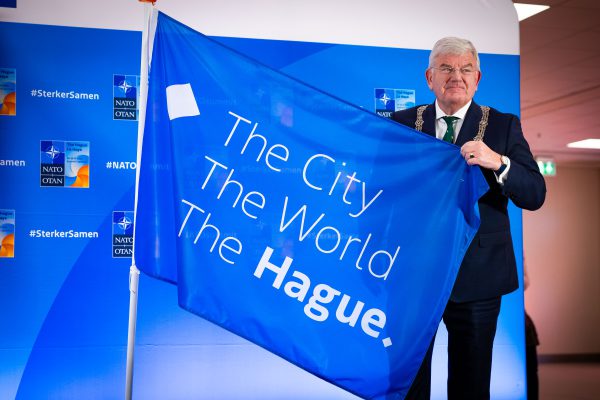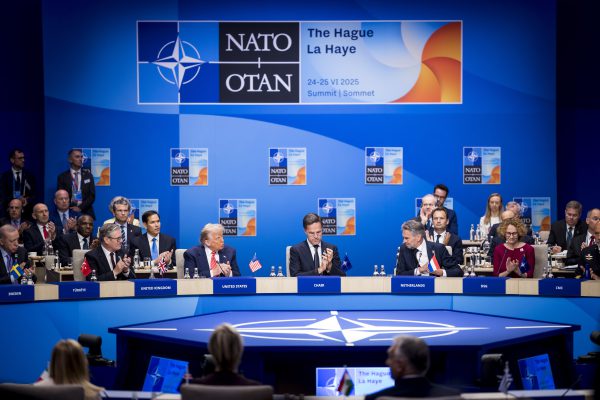NATO Secretary-General and former Prime Minister, Mark Rutte is proud of the success of the NATO Summit in The Hague – the city where he was born and raised, and continues to have a home. It was the first time that the Netherlands had hosted a NATO Summit in its 75-year history. How does Mayor Jan van Zanen look back on the days when all eyes were on The Hague? Nanda Jagusiak-Monteiro of the Holland Times asked him four questions.
Why was the NATO Summit held in The Hague?
For more than 125 years we have been the city of peace, justice and, increasingly, security. The First Peace Conference was held here in 1899. That led to the building of the Peace Palace, the creation of the Permanent Court of Arbitration and later, the International Court of Justice of the United Nations. The start of an ecosystem in and around The Hague which now amounts to some 500 international organisations (including NGOs, diplomatic missions and international knowledge institutes). Besides this, The Hague is known for peace talks and mediation in conflicts around the world; a city where peace negotiations take place and security matters are discussed. We have been a NATO city since 1954. There are 1,100 people working at NATO’s Communications and Information Agency. The security organisations in The Hague and the surrounding region constitute Europe’s largest security cluster. Experience was among their reasons for choosing The Hague for the NATO Summit. Major international meetings and events in the fields of security and sport, for example, have been held here. The successful International Afghanistan Conference in 2009 and the Nuclear Security Summit (NSS) in 2014 demonstrated that we are capable of hosting meetings of this scale.
What did the Summit mean for The Hague?
Hosting the NATO Summit involved the largest logistical operation for the Netherlands since World War II, with two years of preparation in the run up. Streets and areas around the conference site and several hotels were temporarily cordoned off and an emergency ordinance was in effect for the duration of the summit. Considerable effort was put into involving residents and local business owners. For example, a well-attended weekly meeting was organised where residents and the business community could ask questions and discuss their concerns. Plus another 60 meetings were held with residents’ groups and organisations. To minimise the disruption for local people and other parties, custom solutions were used wherever possible. To support businesses and organisations, maps with practical information about diversions were distributed and tens of thousands of letters were sent to keep everyone well-informed. We did everything we could to keep residents and business owners fully up-to-date and to tackle problems immediately. During the summit itself there were teams from the municipality on hand to answer questions and provide support where necessary.
How did the Summit go?
The NATO Summit was impressive, welcoming and almost without incident. An achievement made possible thanks to the efforts of thousands of professionals with the support of involved residents and visitors. The Hague welcomed 45 heads of state, ministers of defence and foreign affairs, 6,000 delegation members and 2,000 journalists (see NATO Summit Facts & Figures). The results were all the more important given these times of increasing geopolitical tensions. The notable raising of the defence budgets of all NATO countries to 5% of GDP may well go down in history as The Hague Defence Commitment. The situation in the city remained calm and manageable which was also due to the fact that every conceivable scenario had been rehearsed in advance. There were various demonstrations but they took place without any major disturbances. Demonstrating is a fundamental right. Most particularly in The Hague – the heart of the Netherlands’ parliamentary democracy and the nation’s demonstration capital – it is important that this is still possible, even during a major summit with many security measures.
Various activities were organised as part of a wide-ranging support programme in The Hague, entitled Road to Summit, to bring the themes of peace and justice closer to as many people in the city as possible. And focusing on various topics, such as democracy, diversity and inclusion, security and cybersecurity, equality and inequality, as well as climate. These activities began on 28 January, culminating in the Just Peace Festival from 12 to 26 June. The different events attracted more than 30,000 visitors. The opening of the meeting venue immediately after the end of the NATO Summit on Wednesday evening, 25 June, also attracted many people. Local people living around the World Forum received a personal invitation to this event to ensure that they could see it.
What impact did the Summit have on The Hague?
The NATO Summit has once again put The Hague on the map, nationally and internationally, as the city of peace and justice and as a place where important decisions are made that affect the lives of people worldwide. The successful summit has again confirmed The Hague’s ability to host international events of this stature. We are therefore stepping up our efforts to attract conferences and other events to our city. We are looking carefully at the available options for renovating and expanding the World Forum. The strengthening of The Hague’s international profile as a result of the NATO Summit is also beneficial in terms of attracting new international organisations, such as the European Tribunal on the crime of aggression against Ukraine. The success of the NATO Summit also provides a boost for the security cluster in and around The Hague. So, this is how, in The Hague, we are continuing to build on the legacy of the past 125 years of working towards a peaceful, secure and just world.
NATO summit Facts & Figures
- 2-day NATO Summit
- 2 continents with NATO members: North America and Europe
- Founded in 1949. The Netherlands has been a member since 1949
- Article 5 is the most important article in the North Atlantic Treaty: an attack on one member state is considered an attack on all member states
- 32 NATO member states
- 45 heads of state and government leaders
- 45 ministers of foreign affairs
- 45 ministers of defence
- 400 invited to the NATO Summit Defence Industry Forum: a meeting of NATO and the defence industry
- 2,000 journalists
- 6,000 delegation members
- 8,500 visitors in total
- 27,000 police officers
- 5,000 military personnel
- 5 kilometres of security barricades around The Hague during the NATO Summit
- 22 text vehicles indicating diversions
- 700 barriers to cordon off streets (roughly)
- 1,000 no entry traffic signs (roughly)
- 1,400 bollards for road closures
- 70 municipal traffic controllers (excluding police traffic controllers)
- 1,100 diversion signs
- 1,100 people at the NATO communications centre providing reliable, up-to-date information
- Tens of thousands of letters sent to residents by the municipality about the coming NATO Summit
- 13 drop-in municipal surgeries held
- 225 residents and business owners spoken to
- 60 other meetings
- 75 customised maps
- 618 croissants and 1,182 cups of coffee at newspaper stand
Written by Jan van Zanen,
Mayor of The Hague



